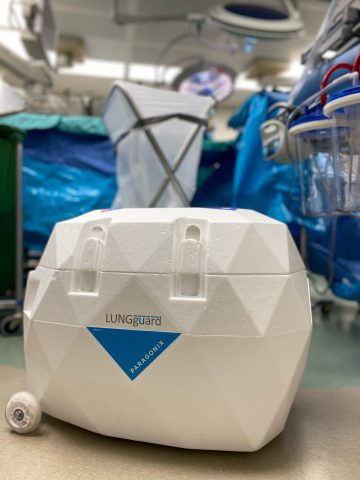February 22, 2021
LUNGguard Donor Lung Preservation System Update: Paragonix Technologies notes the first-in-man clinical use of the only FDA cleared cold storage device for donor lungs, its LUNGguard Donor Lung Preservation System, by Duke University Hospital.
“Donor lungs are sensitive to injury and the current ice storage of lungs risks cellular injury, especially with the increasing transport distances and times now experienced by lung transplant centers,” said John Haney, MD, MPH, Surgical Director, Duke Lung Transplant. Dr. Haney was the implanting transplant surgeon on the first four cases using the LUNGguard Donor Lung Preservation System. “Duke Health is committed to pioneering new innovations that benefit transplant patients and changing the way donor lungs are transported has this potential.”
The first-in-the-world use of the LUNGguard Donor Lung Preservation System preserved donor lungs for 7 hours on their journey to provide a patient suffering from Idiopathic Pulmonary Fibrosis (IPF) with new lungs. Since the initial first-in-man, the Duke team has performed an additional four lung transplantations using the LUNGguard System. These early cases have demonstrated the versatility of the device in multiple applications including DCD and DBD donors, total ischemic times from 3 hours to 12 hours, and indications varying from emphysema to cystic fibrosis.
The LUNGguard System represents a radical advance from ice and off-the-shelf coolers that has been the standard-of-care for over 50 years of organ transplantation. For the first time, transplant teams have access to an FDA cleared and CE-marked hypothermic lung preservation device that can precisely maintain and monitor the environment necessary for donor lungs.
“At Carolina Donor Services, our mission is to maximize the passing of the heroic gift of life from one person to another through organ donation. We are constantly embracing new technologies that will help safeguard organs and ensure better outcomes for those patients waiting for the gift of life,” said Danielle Niedfeldt, President and CEO of Carolina Donor Services, the organ donation organization that supported these cases. “I am honored that our team could be part of the first-in-man use of the LUNGguard system and we are excited by its positive impact in lung transplantation and saving more lives.”
The development of this system has been supported by a collaboration between Paragonix and the Lung Transplant Foundation, a leading lung transplant patient advocacy group. “The LUNGguard device is a project that we have been working on with Paragonix for the past three years because we saw the critical need for this technology in lung transplantation. To be able to help another IPF patient in the first-in-man case could not have been more significant to me personally,” said Jeffery Goldstein, President, and Founder of the Lung Transplant Foundation and lung transplant recipient.
The LUNGguard Donor Lung Preservation System is the latest addition to the Paragonix portfolio of organ preservation and transport systems. It is built on the same proven technology architecture as the Paragonix™ SherpaPak Cardiac Transport System, which has been widely adopted for heart transplantation over the past two years. Additionally, Paragonix has FDA cleared and CE marked systems for kidney, liver, and pancreas transplantation.
“Our team at Paragonix strives to provide donor organs and transplant recipients every possible advantage for a second chance at life,” said Lisa Anderson, Ph.D., Founder, President, and COO of Paragonix Technologies. “We are honored to partner with the team at Duke and Carolina Donor Services to reach this incredible milestone and begin making an impact to as many lung transplant patients as possible.”



